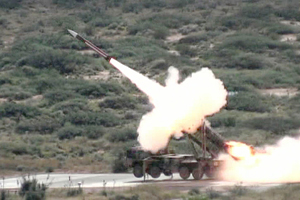ARLINGTON, Va., June 18, 2010 — Unidentified remains of 14 fallen Air Force AC-130 gunship crewmembers were laid to rest at Arlington National Cemetery here yesterday, nearly 40 years after their aircraft was shot down over southern Laos.
Lt. Col. Henry P. Brauner, Lt. Col. Richard Castillo, Lt. Col. Irving B. Ramsower II, Lt. Col. Howard D. Stephenson, Maj. Curtis D. Miller, Maj. Barclay B. Young, Capt. Richard C. Halpin, Capt. Charles J. Wanzel III, Chief Master Sgt. Edwin J. Pearce, Senior Master Sgt. James K. Caniford, Senior Master Sgt. Robert E. Simmons, Senior Master Sgt. Edward D. Smith Jr., Master Sgt. Merlyn L. Paulson and Master Sgt. William A. Todd were honored in a group burial with full military honors in the cemetery’s Section 60.
The crew was killed in action March 29, 1972, in the midst of the Vietnam War.
Air Force Lt. Gen. Mark D. Shackelford presented an American flag to the families. Air Force Chaplain (Capt.) Anthony Wade and Rev. Martin McGill presided over the service.
Full military honors included a flag-draped casket and carrying team, a firing party, a band and bugler, a horse-drawn caisson and escorts from the Air Force Honor Guard. All 14 names will be included on the headstone.
Representatives from the families of 13 of the airmen attended the ceremony. Several members of Rolling Thunder, an advocacy group for the return of all prisoners of war and those missing in action, also attended the service.
Remains for Halpin, Wenzel, Caniford, Pearce, Simmons, Smith and Todd were positively identified and returned to their families. Young and Caniford were buried here individually in 2008, said Kaitlin Horst, a spokeswoman for the cemetery.
The remaining seven airmen could not be identified, but are accounted for, Larry Greer, a spokesman for the Pentagon’s Joint Prisoners of War and Missing in Action Accounting Command, said in an interview today with American Forces Press Service.
Forensic anthropologists and scientists from the Defense Department are confident all 14 airmen were involved in the crash, Greer said. The scientists used identification tools, circumstantial evidence and DNA tests to match the crewmembers’ remains with their families, Greer said. Scientists also used dental comparisons to identify remains.
“All of these men have been accounted for, and the families have accepted the identification,” Greer said. “These final, full-honor services are to recognize the sacrifices that these men made and their families made, and all of us involved in this mission feel it an honor to bring closure to these families.”
The crew’s plane was shot down by a surface-to-air missile during an armed reconnaissance mission. Search and rescue efforts were hindered because of heavy enemy activity in the area and were stopped after only a few days, Greer said.
The first remains were recovered in 1986 by a joint U.S.-Laos team, Greer said. Recovered items included two identification tags, life support equipment and aircraft wreckage, he added.
Between 1986 and 1998, nine members of the aircrew were positively identified. Follow-on surveys and excavations in 2005 and 2006 found more remains, personal effects and other equipment, he said.
The remains of more than 900 servicemembers killed in the Vietnam War have been returned to their families since 1972. More than 1,700 remain unaccounted-for.
In the past year, the Joint Prisoners of War and Missing in Action Accounting Command has accounted for 98 servicemembers missing from the Korean War, Vietnam War and World War II. More than 80,000 servicemembers from the three wars remain unaccounted-for. Nearly 2,000 from the same wars have been accounted for and returned to their families.
Source:
U.S. Department of Defense
Office of the Assistant Secretary of Defense (Public Affairs)

 von
von 
